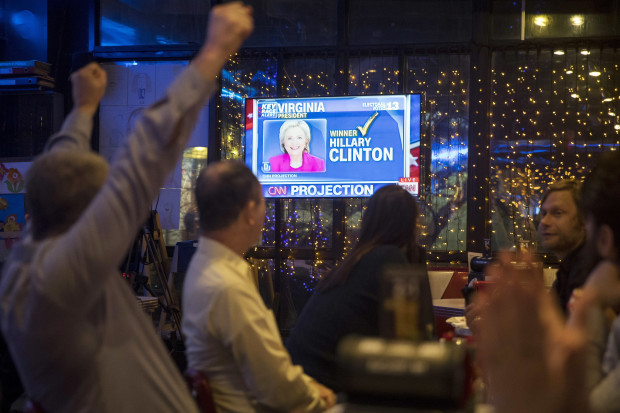
Andrew Hardisty of the U.S., left, and other people react as they watch a live telecast of the U.S. presidential election in a cafe in Moscow, Russia, Wednesday, Nov. 9, 2016. Around the world, people reacted with fears and cheers to news of the election of Donald Trump. AP
WASHINGTON—Republican Donald Trump’s astonishing White House victory over Democratic favorite Hillary Clinton produced another demonstrably clear loser in the process: US polling.
Such was the scope of the failures of pollsters’ and forecasters on Tuesday night that the future of the entire industry was being thrown into question.
Of the 20 major polling institutions including national networks, prominent newspapers and news wires that conducted more than 80 polls since mid-September, only one organization—The Los Angeles Times paired with USC Tracking—consistently gave Trump the edge.
‘Terrible’ polls
On Election Day morning, the RealClearPolitics rolling average showed Clinton ahead by 3.3 percentage points nationally. Hours later, the polling community was offering a collective “oops.”
Respected election forecaster Nate Silver’s short answer on how polls performed: “terrible.”
Silver’s blog, FiveThirtyEight.com, had forecast Clinton would win key battleground states Florida, North Carolina, Pennsylvania and Wisconsin. Trump won all four, and the election.
The esteemed New York Times forecast unit, the Upshot, had given Clinton an 85-percent chance of victory, even proclaiming her a 93 percent favorite to win Wisconsin.
Agence France-Presse (AFP) talked with political professor Larry Sabato, director of University of Virginia’s Center for Politics and author of Sabato’s Crystal Ball, which, like most forecasters, had predicted a Clinton victory.
“The crystal ball has a big crack in it, my friend,” Sabato said.
Why polls were so wrong
“It’s pretty obvious that something happened here,” Sabato said of the fundamental misreading, noting there have been literally hundreds of presidential polls conducted this year.
Many pollsters weight their samples based on the electorate as it was composed in prior election contests, according to Sabato.
That proved their undoing, because polls simply underestimated the number of quiet, poll-avoiding Trump supporters out there.
“White turnout in rural America was through the ever-loving roof,” Sabato said, while African-American and millennial turnout was down.
While pollsters anticipated a drop in the black and youth votes compared to 2012 when President Barack Obama ran for reelection, “their likely voter screens simply did not catch the high impending turnout in these white rural areas,” he added.
The Clinton campaign’s own internal tracking polls also badly misread the white working-class vote, according to one election analyst who studied them and spoke to AFP on condition of anonymity to discuss campaign team data.
“They were completely wrong—and they spent a fortune,” the analyst said.
No, said Sabato. “The surveys showed a lot of that.”
But others begrudgingly realized that pollsters may not have understood the depth of the resentment toward the former first lady, New York senator and US secretary of state, whom many saw as a corrupt member of the elite Washington establishment.
“I had no idea how deep the divisions are,” Democratic strategist Paul Begala acknowledged on CNN.
Sabato said he was “just flummoxed,” considering “literally hundreds of surveys are wrong.”—AFP